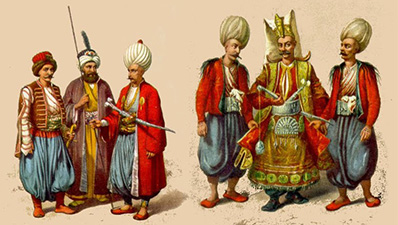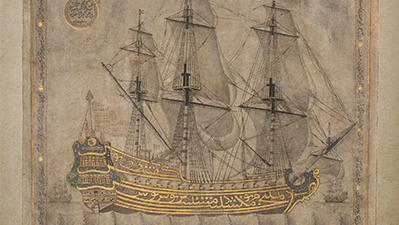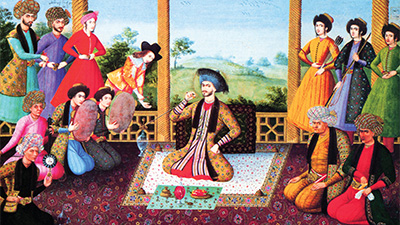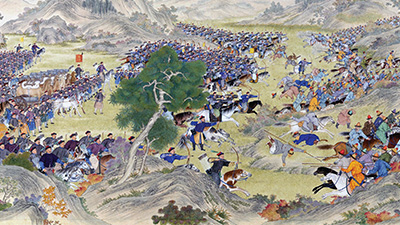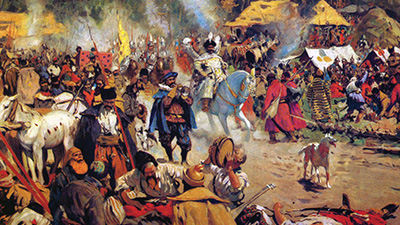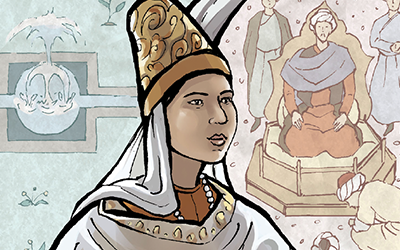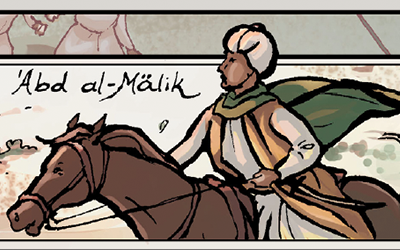Empires Expand
Teacher Resources
Driving Question: How and why did various land-based empires develop and expand from 1450 to 1750 CE?
Large land-based empires exerted control over vast regions of Afro-Eurasia during this period. While empires certainly weren’t new, the land-based empires covered in this lesson ruled over diverse peoples and large geographic areas. So, how did these empires ensure that their subjects obeyed the empire’s rules?
Learning Objectives:
- Evaluate the similarities and differences between how and why various land-based empires, such as the Manchu, Mughal, Ottoman, and Safavid, developed and expanded from 1450 to 1750.
- Investigate the role of various technological innovations, such as gunpowder, on the formation of land-based empires.
- Assess how political and religious disputes led to conflict between empires.
- Use the historical reasoning process of comparison to analyze the similarities and differences between various land-based empires.
- Use the historical thinking practice of claim testing to learn how to analyze the quality of evidence used to support claims.
- Use graphic biographies as microhistories to support, extend, or challenge the overarching narratives from this region.
Vocab Terms:
- boyar
- cosmopolitan
- imam
- Janissary
- Reformation
- Shia
- Sunni
- tsar
Opener: Empires Expand
To teach this lesson step, refer to page 3 of Lesson 3.1 Teaching Guide.
If you were an emperor, how would you help feed and protect your people?
Gunpowder Empires
To teach this lesson step, refer to page 3 of Lesson 3.1 Teaching Guide.
This discussion suggests different activities that engage students with the history of technology.
Having a strategy is important means to achieving your objectives. The most successful strategies may take a multi-pronged approach, making them even more effective.
-
Guiding Questions
-
Before you read
Preview the questions below, and then skim the article. Be sure to look at the section headings and any images.
While you read
Look for answers to these questions:
- Which empires are referred to as “gunpowder empires” and why are they called this?
- How did gunpowder help emperors rule their territory?
- How were the Mongols important to these new empires?
- How did these empires use religion to govern?
- How did gunpowder technology change political dynamics in Europe?
After you read
Respond to the following questions:
- Do you think “gunpowder empires” is a good name for this group of empires? Why or why not? Can you think up a better name?
Comparison: Empires
To teach this lesson step, refer to page 4 of Lesson 3.1 Teaching Guide.
This Comparison One-Pager is your one-stop resource for this fundamental historical thinking skill.
Why are some empires successful while others fail? You will compare the functionality of empires and answer this question.
-
Guiding Questions
-
Before you read
Preview the questions below, and then skim the article. Be sure to look at the section headings and any images.
While you read
Look for answers to these questions:
- Why does the author argue that the story of Master Orban is problematic?
- What factors are listed in this article as contributing to Ottoman success?
- Why was the lack of a permanent aristocracy an advantage?
- What was the devshirme?
- What other title did the sultans claim? Why was this important?
After you read
Respond to the following questions:
- What similarities and differences do you see between the Ottoman Empire and other empires you have encountered in previous units?
- The author describes several different factors that contributed to the Ottoman Empire’s success during this period. Which factor do you think was most important? Would you place this factor under the category of governance, cultural developments and interactions, or economic systems? Why?
-
Guiding Questions
-
Before you read
Preview the questions below, and then skim the article. Be sure to look at the section headings and any images.
While you read
Look for answers to these questions:
- What type of Islam was practiced by the founders and the majority of the people in the Persian Safavid Empire?
- Why was the region of Persia (modern-day Iran) so diverse at the time of the founding of the Safavid Empire?
- What was the Mahdi within the Safavid Islamic tradition?
- How was marriage strategic and political among the Safavid Qizilbash (“Red Turban”) ruling elite?
- What neighboring state fought with the Safavids the most and why?
After you read
Respond to the following questions:
- What were the tools the Safavid rulers used to govern this large and diverse state? How effective were those strategies?
- The Islamic tradition is very diverse, with many different groups practicing Islam in different ways. How important do you think religious diversity within the Islamic world was in the history of the Safavid Empire?
-
Guiding Questions
-
Before you read
Preview the questions below, and then skim the article. Be sure to look at the section headings and any images.
While you read
Look for answers to these questions:
- What were the two dynasties that ruled China from 1450 to 1750, and what were their periods of rule?
- What was the “turn inland” after 1433, and why did it happen according to the author?
- What was the focus of the Yongle Emperor according to the article?
- What caused the fall of the Ming dynasty and the rise of the Qing dynasty around 1640?
- What policies did the Kangxi Emperor pursue?
After you read
Respond to the following questions:
- To what extent does this article explain how rulers used a variety of methods to legitimize and consolidate their power in land-based empires from 1450 to 1750?
- For many decades, world historians saw China’s turn “inward” (or “inland”) as a mistake, because it slowly allowed Europeans to dominate global trade. Many historians now argue, however, that it was a logical decision given China’s needs in the fifteenth through the seventeenth centuries. Do you think these policies were a mistake? Why or why not? What evidence from this article supports or challenges your argument?
-
Guiding Questions
-
Before you read
Preview the questions below, and then skim the article. Be sure to look at the section headings and any images.
While you read
Look for answers to these questions:
- Why have historians generally paid more attention to southern Eurasia than northern Eurasia?
- What northern Eurasian group had a huge impact on the entire region in the thirteenth century?
- Who drove the Mongol “Golden Horde” out of Muscovy, the region around today’s Moscow?
- How long did the Romanovs rule the Russian Empire?
- Who were the serfs and who were the boyars in imperial Russia? What were their roles?
- How and where did the Russian Empire expand under the Romanovs?
After you read
Respond to the following questions:
- To what extent does this article explain how rulers used a variety of methods to legitimize and consolidate their power in land-based empires from 1450 to 1750?
- How did the role of the Orthodox Church in Muscovy/Russia compare with the role of religions in other Eurasian land-based empires?
-
Guiding Questions
-
Before you read
Preview the questions below, and then skim the article. Be sure to look at the section headings and any images.
While you read
Look for answers to these questions:
- The author suggests that we generally perceive South Asia as having a timeless conflict between Hindu and Muslim communities. To what degree is this an accurate depiction of the region in this period?
- What were some factors in the success of the Mughal Empire?
- Was the emperor Aurangzeb a tolerant or intolerant ruler? How do we know?
- Why did the Mughal Empire fragment in the eighteenth century?
After you read
Respond to the following questions:
- Using evidence from the article, describe how it extends your understanding of how rulers used a variety of methods to legitimize and consolidate their power in land-based empires from 1450 to 1750.
- What factors stand out to you as particularly distinct and important in how the Mughal Empire was ruled and organized? How does this compare to other regions you have studied for this era?
Graphic Biography: Khanzada Begum
To teach this lesson step, refer to page 15 of Lesson 3.1 Teaching Guide.
Looking to differentiate, modify or adapt this assignment? Check out our Differentiation Guide.
In this lesson you’ve learned about many empires, all of which were ruled by men. Khanzada Begum was a Timurid noblewoman who played an important role in the Mughal Dynasty, demonstrating how the household and the state often overlapped.
-
Guiding Questions
-
Before you read
Skim the full comic, paying attention to things like prominent colors, shapes, and types of text and fonts. How do you know where to start and which direction to read? What’s in the gutters (the space between panels)? Who is the focus of the comic? What big questions do you have?
While you read
Look for answers to these questions:
- How was Khanzada Begum related to the first Mughal Emperors, Babur and Humayun?
- Why did Khanzada Begum marry Muhammad Shaybani Khan, and why were they divorced?
- How did Khanzada Begum help her brother in his conflict with the Uzbeks after her divorce?
- How did Khanzada Begum help her nephew rule?
- How does the artist use art and design to demonstrate the power and authority of Khanzada Begum?
After you read
Respond to the following questions:
- Using evidence from this article, explain how and why various land-based empires developed and expanded from 1450 to 1750.
- How does this biography of Khanzada Begum support, extend, or challenge what you have learned about the “gunpowder empires,” and government generally, in this era?
Claim Testing: Evidence
To teach this lesson step, refer to page 16 of Lesson 3.1 Teaching Guide.
Do you believe everything on the internet? Check out this blog post about claim testing in the modern world.
You’ve probably realized that evidence is crucial—both for making your own claims and testing the claims of others. But be careful: Some evidence is better than others.
Europe: Exception or Variety?
To teach this lesson step, refer to page 17 of Lesson 3.1 Teaching Guide.
Was Europe just a part of Eurasia, or was it something more? This article compares European empires with those of Asia.
-
Guiding Questions
-
Skim
Before you read, you should quickly skim the article, by looking at the headings of each section and the charts. Read the questions below as well, so you know what to look for when you read!
Key Ideas
- How do the size of Europe and Asia compare?
- Did Europe ever fully come together as a single large land-based empire? How do the Habsburg Empire compare to the Asian empires of this early modern period?
- How did the rise of Protestantism challenge Habsburg domination of Europe?
- In this early modern period (1450–1750) was Europe alone as a maritime or sea-faring region?
- How did the end of the early modern period shape the story we are challenging here about European uniqueness?
Evaluate
- To what extent does this article help to explain continuity and change within the various belief systems during the period from 1450 to 1750?
- Why does it matter whether Europe was an “exception” or “unique” in Eurasia during this period? Why is this debate important for understanding this era in world history?
- Why do you think the idea of European exceptionalism or uniqueness developed, and what can we learn from it? Do you think this type of exceptionalism might also exist in the schoolbook histories of other regions like Turkey (successor to the Ottoman Empire) and China (formerly the Qing)?
Closer: Empires Expand
To teach this lesson step, refer to page 19 of Lesson 3.1 Teaching Guide.
Moroccan Sultan Mawläy ‘Abd al-Mälik had his hands full defending his kingdom against multiple threats—Ottoman Sultans, Christian Europeans, and even his own relatives!!
-
Guiding Questions
-
Before you read
Skim the full comic, paying attention to things like prominent colors, shapes, and types of text and fonts. How do you know where to start and which direction to read? What’s in the gutters (the space between panels)? Who is the focus of the comic? What big questions do you have?
While you read
Look for answers to these questions:
- Which countries were the main threats to Morocco during the period of Sa’âdi rule, and what were the religions of their leaders?
- Who was Mawläy ‘Abd al-Mälik’s main rival for the Moroccan throne, and to whom did this competitor turn for support?
- In your own words, what was in Mawläy ‘Abd al-Mälik’s letter to Don Sebastián I?
- What was the outcome of the Battle of the Three Kings?
- Why do you think the artist drew the Atlantic Ocean and Mediterranean Sea criss-crossed by lines in the top panel?
After you read
Respond to the following questions:
- How does this graphic biography help you understand the connection between belief systems and empires of this era?
- How does this biography of Mawläy ‘Abd al-Mälik support, extend, or challenge what you have learned about international relations and conflict in this period?


